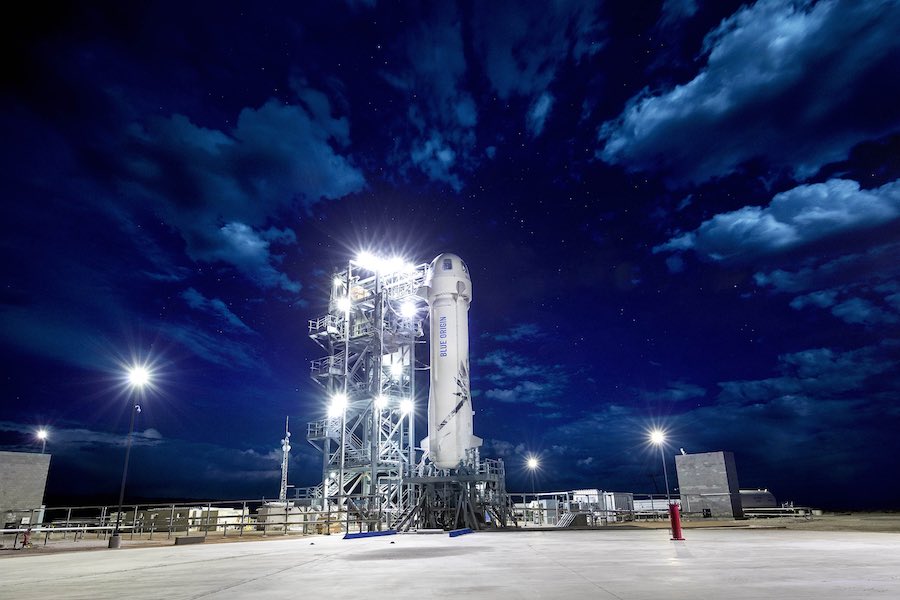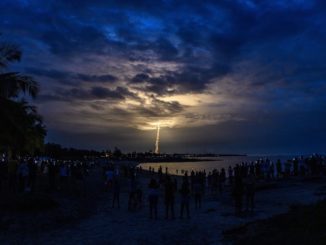EDITOR’S NOTE: Updated at 9 a.m. EST (1400 GMT) Dec. 18 with Blue Origin’s announcement of a scrubbed launch attempt. Updated at 10:30 p.m. EST on Dec. 18 (0330 GMT on Dec. 19) with new target launch date. Updated again Dec. 19 with Blue Origin’s announcement of a delay to early 2019.

Blue Origin scrubbed the planned launch Tuesday of the company’s suborbital New Shepard booster from West Texas due to a “ground infrastructure issue,” and later said the flight would be pushed back to early 2019.
Liftoff was set for 8:30 a.m. CST (9:30 a.m. EST; 1430 GMT) Tuesday from Blue Origin’s sprawling test facility north of Van Horn, Texas, but Blue Origin tweeted shortly before 8 a.m. CST that the launch was delayed.
“We are scrubbing today’s #NewShepard launch due to a ground infrastructure issue,” Blue Origin tweeted Tuesday morning. “The vehicle is in good standing. Stand by for updates as we see what weather looks like for tomorrow.”
Blue Origin tweeted an update later Tuesday: “Still working through ground infrastructure issues and monitoring incoming weather in West Texas. Slating next launch window NET Friday 12/21 pending further review. Stay tuned for updates as we learn more.”
A subsequent update tweeted by Blue Origin Wednesday said: “Through fixing the ground infrastructure issue, we have determined additional systems need to be addressed. We have changed our target to early 2019 for next launch attempt.”
When it takes off, the flight is expected to climb to an altitude of more than 60 miles — or 100 kilometers — powered by a hydrogen-fueled BE-3 engine. The NASA research payloads will fly inside a crew capsule on top of the New Shepard booster, but no passengers will be aboard the launch.
The booster and capsule will separate after shut down of the rocket’s main engine. Both vehicles will come back to Earth, with the rocket aiming for a controlled vertical touchdown on a landing pad with the help of a braking burn, and the capsule parachuting to the desert floor a few miles away.
Founded and funded by Amazon billionaire Jeff Bezos, Blue Origin plans to fly people on a New Shepard launch next year. The booster set to fly again this week is the third New Shepard propulsion module produced by Blue Origin, and the company says a fourth New Shepard rocket — the one intended to carry humans on suborbital trips to space — has arrived at the West Texas launch site from its factory near Seattle.
The upcoming flight will be the 10th launch of a New Shepard vehicle, and the fourth flight with the third New Shepard propulsion module. It will also be Blue Origin’s first flight since July 18, when engineers demonstrated the vehicle’s high-altitude abort capability.
The capsule’s solid-fueled abort motor fired to quickly accelerate the craft away from the rocket, simulating the escape maneuver passengers would use to quickly get away from a failing booster at high altitude. Blue Origin accomplished a lower-altitude abort demonstration in 2016.
Blue Origin is expected to use the same booster and crew capsule from the July mission on the upcoming launch, which was scheduled less than a week after one of the company’s main competitors in the suborbital space tourism market — Virgin Galactic — flew its SpaceShipTwo rocket plane to the edge of space for the first time with two test pilots at the controls.
The SpaceShipTwo rocket plane reached a maximum altitude of 51.4 miles, or 82.7 kilometers, on Thursday’s test flight, above the 50-mile mark used by the U.S. Air Force and the Federal Aviation Administration to determine who gets awarded astronaut wings. Blue Origin’s New Shepard flights, none of which have carried passengers or employees to date, have reached altitudes over the 100-kilometer (62-mile) Kármán line, the internationally-recognized boundary of space.
An April 29 New Shepard test launch flew to an altitude of 351,000 feet, or about 107 kilometers. Bezos said that is the altitude Blue Origin targets for operational New Shepard flights.
Blue Origin has not announced ticket prices for passengers seeking to ride New Shepard, and the company is not yet taking deposits. Virgin Galactic has received deposits from hundreds of would-be space tourist toward the $250,000 price of a ride on SpaceShipTwo.
While Virgin Galactic’s SpaceShipTwo vehicle uses an airborne release to fire into space and lands on a runway under manual pilot control, Blue Origin’s fully-automated New Shepard rocket and crew capsule takes off vertically from a launch pad, followed by a propulsive landing of the booster and a parachute-assisted return of the passenger-carrying module — a flight profile expected to be demonstrated again with Tuesday’s mission.
“Jeff is running a very similar kind of company to us, but a very different experience as passengers,” said Richard Branson, founder of Virgin Galactic and Virgin Group, in an interview Thursday with CNBC. “His will be a land-based rocket, our’s is a spaceship that flies and comes back down on its wheels. His comes back down on a parachute. They’re both, I think, very valid. I think they’ll both be tremendous experiences for people, and my guess is that people will want to try both if they can afford it.”
The nine NASA-sponsored experiments slated to fly to space on New Shepard’s 10th mission include payloads from universities and NASA centers examining the behavior of a “green” non-toxic fuel in microgravity, demonstrating a way to measure fuel levels in microgravity using sound waves, testing technology to cool electronics in space, and measuring the naturally-occurring electromagnetic fields inside and outside the spacecraft.
Other NASA payloads include a pair of planetary science investigations from the University of Central Florida to help scientists better understand how dust particles on other planets might respond to human and robotic contact, and to evaluate the performance of an asteroid sample retrieval mechanism in a low-gravity environment. New Shepard will also carry an experimental imager that could be used to support future biological investigations on suborbital rockets, a vibration isolation platform to protect experiments from the shaking and forces encountered in flight, and a data recorder to log temperature, pressure, carbon dioxide levels, acoustic conditions and acceleration inside the cabin.
Email the author.
Follow Stephen Clark on Twitter: @StephenClark1.



